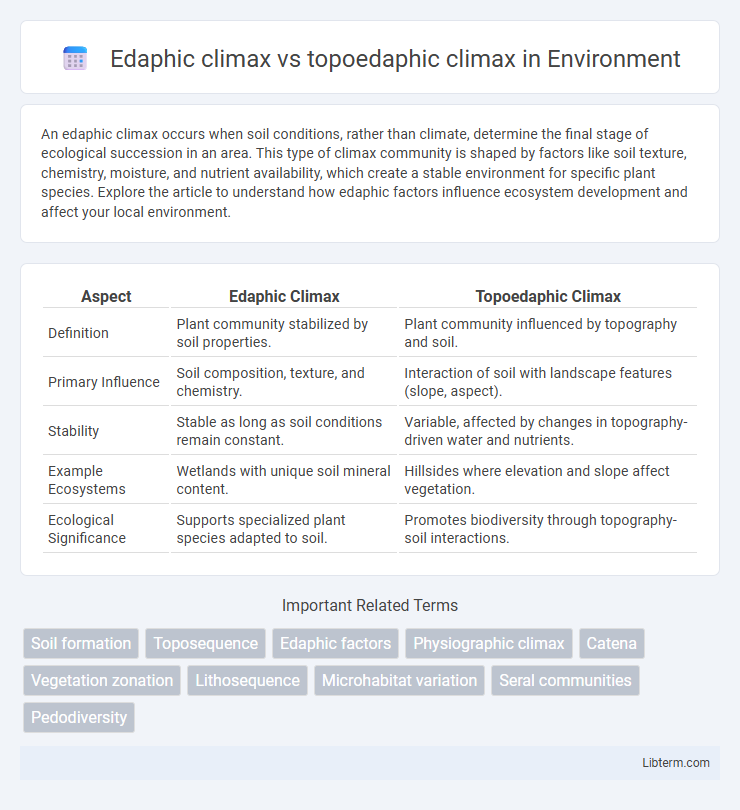An edaphic climax occurs when soil conditions, rather than climate, determine the final stage of ecological succession in an area. This type of climax community is shaped by factors like soil texture, chemistry, moisture, and nutrient availability, which create a stable environment for specific plant species. Explore the article to understand how edaphic factors influence ecosystem development and affect your local environment.
Table of Comparison
| Aspect | Edaphic Climax | Topoedaphic Climax |
|---|---|---|
| Definition | Plant community stabilized by soil properties. | Plant community influenced by topography and soil. |
| Primary Influence | Soil composition, texture, and chemistry. | Interaction of soil with landscape features (slope, aspect). |
| Stability | Stable as long as soil conditions remain constant. | Variable, affected by changes in topography-driven water and nutrients. |
| Example Ecosystems | Wetlands with unique soil mineral content. | Hillsides where elevation and slope affect vegetation. |
| Ecological Significance | Supports specialized plant species adapted to soil. | Promotes biodiversity through topography-soil interactions. |
Introduction to Ecological Climaxes
Edaphic climax refers to a stable ecological community shaped primarily by soil conditions such as texture, moisture, and nutrient availability, leading to distinct vegetation independent of regional climate. Topoedaphic climax involves ecological communities influenced by a combination of topography and soil factors, where slope position, drainage, and soil depth dictate species composition and ecosystem development. Understanding these climaxes is essential in ecology for predicting vegetation patterns and managing ecosystems under varying environmental constraints.
Defining Edaphic Climax
Edaphic climax refers to a stable plant community primarily determined by soil conditions rather than climatic factors, resulting in vegetation adapted to specific soil properties such as pH, moisture, and nutrient availability. This climax stage contrasts with topoedaphic climax, where both topography and soil influence community composition, creating localized variations in vegetation. Understanding edaphic climax highlights the crucial role of soil characteristics in ecological succession and the formation of persistent ecosystems independent of broader climatic influences.
Understanding Topoedaphic Climax
Topoedaphic climax refers to the stable ecological community shaped by both soil properties and topographical features such as slope, aspect, and elevation, resulting in distinct vegetation patterns adapted to microenvironmental variations. Unlike the edaphic climax, which is primarily determined by soil characteristics alone, topoedaphic climax integrates the influence of landforms on soil moisture, nutrient distribution, and microclimate conditions. Understanding topoedaphic climax is crucial for predicting vegetation succession and ecosystem dynamics in heterogeneous landscapes where topography significantly affects ecological stability.
Key Differences Between Edaphic and Topoedaphic Climax
Edaphic climax vegetation is primarily influenced by soil properties such as texture, moisture, and nutrient content, leading to stable communities adapted to specific soil conditions regardless of topography. In contrast, topoedaphic climax results from the combined effects of topography and soil factors, where slope, elevation, and drainage patterns interact with edaphic variables to shape distinct vegetation types. Key differences lie in the dominance of soil alone in edaphic climax versus the integrated influence of topography and soil in topoedaphic climax, affecting species composition and ecosystem stability.
Factors Influencing Edaphic Climax Communities
Edaphic climax communities are primarily influenced by soil properties such as texture, structure, nutrient availability, pH, and moisture retention, which dictate plant species composition and succession stability. Unlike topoedaphic climax communities, which are shaped by both topography and soil factors, edaphic climax focuses solely on soil characteristics regardless of landscape position. These soil-driven factors determine local microhabitats, influencing plant adaptation and community resilience over time.
Role of Topography in Topoedaphic Climax Formation
Topography plays a crucial role in the formation of a topoedaphic climax by influencing soil moisture, drainage, and microclimate conditions, which directly affect vegetation patterns and ecosystem stability. Unlike the edaphic climax, primarily determined by soil characteristics alone, the topoedaphic climax integrates the impact of slope, aspect, altitude, and landform position on soil development and plant community distribution. This dynamic interaction between topographic features and soil properties creates diverse ecological niches that promote distinct climax communities in varying landscape positions.
Examples of Edaphic Climax Vegetation
Edaphic climax vegetation develops primarily due to soil conditions rather than climate, exemplified by longleaf pine in sandy, nutrient-poor soils and mangrove forests thriving in saline, waterlogged sediments. These ecosystems maintain stability despite variations in broader climatic factors, reflecting soil-driven ecological succession. In contrast, topoedaphic climax vegetation arises from combined topographic and edaphic influences, such as xerophytic shrubs on south-facing slopes with shallow soils.
Examples of Topoedaphic Climax Vegetation
Topoedaphic climax vegetation is typically found in landscapes where variations in topography and soil conditions influence plant communities, such as floodplains, slopes, and terraces. Examples include oak-hickory forests on well-drained upland ridges, bottomland hardwood forests in river valleys, and pine barrens on dry, sandy soils. These climax communities contrast with edaphic climax vegetation, which is primarily determined by soil properties independent of topography.
Ecological Importance of Climax Types
Edaphic climax communities develop under specific soil conditions that limit succession, maintaining unique biodiversity and nutrient cycles essential for ecosystem stability. Topoedaphic climax ecosystems arise from combined topographic and soil factors, influencing microclimates and water distribution critical for habitat heterogeneity. Both climax types play vital roles in preserving ecological balance, supporting species adaptation, and sustaining long-term productivity in diverse landscapes.
Conclusion: Implications for Ecosystem Management
Edaphic climax and topoedaphic climax highlight the influence of soil properties and topography on vegetation development, critical for ecosystem management strategies. Recognizing edaphic climax allows targeted soil-specific interventions, while topoedaphic climax emphasizes the need to consider landscape position in restoration efforts. Integrating both concepts enhances adaptive management practices that maintain biodiversity and ecosystem resilience in changing environmental conditions.
Edaphic climax Infographic

 libterm.com
libterm.com